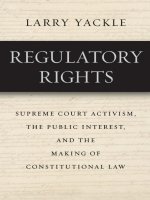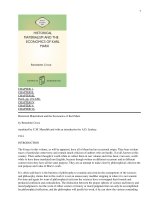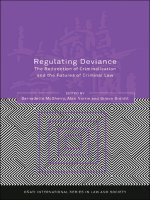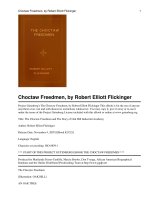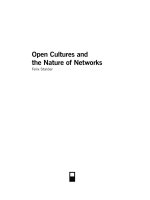Minimum and maximum available prices and the outcome of competition a meta analysis of oligopoly experiments
Bạn đang xem bản rút gọn của tài liệu. Xem và tải ngay bản đầy đủ của tài liệu tại đây (534.21 KB, 48 trang )
MINIMUM AND MAXIMUM AVAILABLE PRICES
AND THE OUTCOME OF COMPETITION:
A META-ANALYSIS OF OLIGOPOLY
EXPERIMENTS
YUE WANG
(B. ECON, HUAZHONG UNIVERSITY OF SCIENCE AND TECHNOLOGY)
A THESIS SUBMITTED
FOR THE DEGREE OF MASTER OF SOCIAL
SCIENCES
DEPARTMENT OF ECONOMICS
NATIONAL UNIVERSITY OF SINGAPORE
2010
Acknowledgement
It is my pleasure to express the deepest appreciation to those who has helped me
with this thesis.
I owe sincere gratitude to my most respected supervisor, A/P Julian Wright, for
his patience, encouragement and illuminating guidance. Through the period of
the writing of this thesis, he has spent much time on each of my drafts and
offered me many valuable suggestions. I want to thank him for generously
sharing me with his knowledge and time. Without his help, this thesis could not
have been completed.
Second, I would like to thank A/P Shandre M. Thangavelu, Dr. Aamir Rafique
Hashmi and Dr. Aggey P. Semenov, who gave me helpful advice after my
presentation of this thesis.
Third, I would like to thank Christoph Engle for providing me with his dataset,
based on which I am able to run the meta-analysis.
i
Table of Contents
Summary .......................................................................................................... iii
List of Tables ..................................................................................................... iv
List of Figures .................................................................................................... v
1.
Introduction ................................................................................................. 1
2.
Literature review ......................................................................................... 6
2.1
2.2
2.3
Nash equilibrium, focal point and folk theorem ............................................. 6
Empirical study, laboratory experiments and meta-analysis ........................... 8
Cognitive Hierarchy model .............................................................................. 9
3.
CH Model’s implication in a Bertrand duopoly game .............................. 10
4.
Methodology of meta-analysis .................................................................. 14
5.
Meta-analysis Results ............................................................................... 17
5.1
5.2
5.3
Consider whole duration for each experiment ............................................. 18
Separate the duration of each experiment into two parts ............................ 20
Normalize the average market price and the average min and max prices .. 22
6.
My experiment .......................................................................................... 23
7.
Conclusion ................................................................................................ 25
Bibliography .................................................................................................... 28
Appendix1. Paper Included in the Meta-study ................................................ 31
Appendix2. Original regression outcomes from Eviews ................................. 35
Appendix3. Instruction for Participants ........................................................... 39
Appendix4. Payoff Table ................................................................................. 41
Appendix5. Experiment result ......................................................................... 42
ii
Summary
How non-binding minimum and maximum available prices affect prices in
oligopoly market is still undetermined. A focal price effect exists in many field
studies but so far no strong evidence is shown in laboratory experiments. In this
thesis, the CH model, as an alternative of standard Nash equilibrium theory, is
used to give a reasonable explanation why minimum and maximum available
prices matter. Then a meta-analysis is taken to examine if those prices affect
average prices and compare the effects under different experiment settings, like
randomly matched or repeated games, Cournot or Bertrand competitions. The
results show that available minimum and maximum prices have a significant
positive effect on the average price controlling for the effect of the Nash
Equilibrium price under almost all set-ups, which satisfies the prediction of CH
model; round effects and market size matter in different way when market
set-ups change. At the end, I run my own experiment of a Bertrand duopoly
game with randomly re-matched subjects and the result is consistent with what I
find in the meta-study.
Key words: oligopoly, experiment, minimum and maximum prices, CH model,
collusion
iii
List of Tables
Table 1…………………………………………………..……………………17
Table 2……………………………………………………………………..…18
Table 3…………………………………………………………………..……24
Table 4……………………………………………………………..…………25
iv
List of Figures
Figure 1 ............................................................................................................ 25
v
1.
Introduction
Price ceilings and floors are common instruments of competition policy. They
have been used at least since ancient Greek times and are still widely used in a
variety of market systems. For as long as price controls have existed, their
effects on welfare and distribution have been debated. But there is a commonly
accepted conception that price controls can only affect prices and outputs when
they are binding; non-binding price controls (that is, those ceilings above or
floors below the competitive equilibrium price) prevent prices from getting
higher than the ceiling or lower than the floor but do not harm competition.
However, some economists have challenged the conclusion above that price
ceilings cannot weaken competition as they may serve as collusive focal point
for pricing, which is known as focal point hypothesis (Schelling, 1960; F. M.
Scherer, 1970). The Folk Theorem (Tirole, 1988) asserts that outcomes of
collusive equilibria are sustainable in infinitely repeated games with
sufficiently high discount factor, while leading to the difficulty of coordination
when firms attempt to collude. Price ceilings facilitate tacit collusion by
providing a focal point on which firms coordinate and increase average market
price. However, focal point hypothesis works only in repeated games with
uncertain end and there is lack of generally accepted model to reveal the
mechanism behind the hypothesis.
Many field studies and a comparatively small number of laboratory
1
experiments have been carried out in this area. While most of field studies show
that non-binding price ceilings facilitate collusion (Sheahan, 1961; Knittel and
Stango, 2003; Eriksson, 2004; Mo, 2007), there is no such evidence in
laboratory experiments. On the other hand, there are different arguments in
relation to the effect of price floor. The argument that a price floor softens the
competition is found in Robert Gagné’s working paper (2006) which analyzes
the effects of price floor on price wars in the retail market for gasoline. Juan
Esteban (2011) tested this hypothesis in the context of an actual regulation
imposed in the retail gasoline market in the Canadian province of Quebec,
which showed that the price floor policy led to more competition. Another
interesting finding in Etienne Billette’s paper (2011) is that in the absence of
collusion, introducing a price floor slightly below the observed transaction
price has no impact on firms’ behaviour. However, the price floor makes
collusive equilibra unsustainable.
In this thesis, I use evidence from existing experiments of oligopoly
markets to test the effect of non-binding price restrictions on prices in one-shot
games, randomly re-matched games and repeated games, both aggregately and
separately. The approach is to see whether the range of prices available to
subjects affects their choice of prices. According to standard Nash equilibrium
theory, the range of prices (above and below the Nash equilibrium price) should
not affect the choice of price once the Nash equilibrium price is added as a
control. In contrast, I show that the Cogitative Hierarchy model, an alternative
2
of standard Nash equilibrium theory, does imply that the minimum and
maximum available price should affect the choice of prices, since the range of
prices affects the prices set by naive decision makers and therefore the prices
set by all higher level thinkers. In this paper, we assume that naïve decision
makers will randomly pick up a number from within the price range, thus the
estimate will be the average of minimum and maximum prices. Different basic
assumptions will lead to different results.
To distinguish CH model and focal point hypothesis, I test both one-shot
game and repeated game. In one-shot games where the focal point hypothesis
cannot offer a proper explanation, I find the result is consistent with CH's
model predictions. In repeated games where the focal point hypothesis can
provide a proper explanation, I only consider the monopoly price lower than
the max price, thus the change of the max price shouldn't affect the average
market price according to the focal point theory. I test this prediction using a
meta-study of previous experiments and find that the average of maximum and
minimum available prices significantly affects the average price set even
though the maximum and minimum available prices are not a binding
restriction in a one-shot game since they lie above and below the one-shot Nash
equilibrium. The evidence is consistent with Cognitive Hierarchy (CH) model
but not Nash equilibrium theory. I also consider the evidence from repeated
games, where the minimum and maximum available prices could affect the
choice of price under existing theories of tacit collusion in repeated games as
3
well as in the CH model, to see whether it differs from that in which subjects do
not have a constant match. To distinguish the implications of the theories, I also
focus on a change in the maximum available price which is above the monopoly
price, which should have no affect on the chosen prices in the standard theories
of tacit collusion but will have an affect under the CH theory. Moreover, the
tacit collusion theories have opposite predictions for prices below one-shot
Nash, which I cannot eliminate in this meta-study. According to tacit collusion
theories, the higher minimum price is, the lower the average price will be, since
punishment is less severe. On the other hand, according to the CH model and
the preliminary assumption, only the average of minimum and maximum
prices matters, so it is difficult to measure the effect of price floors separately,
which is consistent with previous empirical studies, where the effect of price
floors is unclear.
Oligopoly has been among the hottest topics in experimental economics
for many years. There have been more than 154 experimental papers published
since 1959 and most of the papers contain more than one experiment, which
provide a huge database for meta-study in this area. In the paper How much
collusion? A meta-analysis of oligopoly experiments, Engle (2007) aggregates
those experiments and conducts a meta-study among them, trying to answer the
question that how different experimental settings influence the strategic
variable of the oligopolies, like price and quantity, but he overlooks the effect of
minimum and maximum available prices and has not checked it in his study. I
4
look through the experiments included in his meta-study, select the ones with
payoff tables or minimum and maximum available prices and synthesize them
to test the relationship between the average price, minimum and maximum
available prices and other experiment parameters with regression analysis. The
different minimum and maximum available prices set in different experiments
provide enough variances even though they are not what the experiments have
set out to test.
After that, I conduct my own experiment of a Bertrand duopoly game with
randomly re-matched symmetric and differentiate settings. The 16 participants
are graduate students with different majors and the experiment lasts about 2
hours. Minimum and maximum available prices have been changed four times
during the experiment to test how the changes affect average prices with
eliminating round effect. The results of both meta-analysis and my own
experiment confirm CH model’s implication.
The remainder of this article is organized as follows. Section 2 summarizes
previous related papers. Section 3 presents the main idea of CH model, how to
apply CH model to a simple Bertrand game and predict the average market price
with it. Section 4 specifies the methodology. Section 5 presents the results.
Section 6 introduces our own experimental design and analyzes our data.
Section 7 addresses the conclusion.
5
2.
Literature review
We now provide more details about the related literatures concerning the
traditional IO theory, empirical studies and experimental ones, and CH model.
2.1 Nash equilibrium, focal point and folk theorem
In traditional IO theory, there are two basic models in oligopoly market,
Cournot competition and Bertrand competition. A version of the Nash
equilibrium concept was first used by Antoine Augustin Cournot (1838) in his
theory of oligopoly. In Cournot's theory, firms choose how much output to
produce to maximize their own profit. However, the best output for one firm
depends on the outputs of others. Cournot equilibrium occurs when each firm's
output maximizes its profits given the output of the other firms, which is a
pure strategy Nash Equilibrium. Bertrand (1883), on the other hand, describes
another model which simulates oligopoly market as firms competing in price.
Bertrand equilibrium occurs when each firm's output maximizes its profits
given the price of the other firms. Non-cooperative outcome is the only Nash
equilibrium of both models. Thus, we can expect that Nash equilibrium price
will be a good approximation of the average price in an oligopoly market both
in Cournot competition setting and Bertrand one. Consequently, average price
will not be influenced by changing price range from which they can choose
from as far as Nash price is within the range.
We consider one-shot game above, but when it comes to repeated games,
6
things will be different. The early statement is from Friedman (1971) in his
paper that any average payoff vector that is better for all players than a
Nash-equilibrium payoff vector of the constituent game can be sustained as
the outcome of a perfect equilibrium of the infinitely repeated games if the
players are sufficiently patient. Following this statement, Tirole (1988) further
asserts and proofs that feasible outcomes of collusive equilibria are sustainable
in infinitely repeated games with sufficiently high discount factor, which is so
called “folk theorem” in game theory. Under this situation, more than one
feasible choice will cause trouble for people to collude at one certain point
without communication. The concept of focal point, which is also called
Shelling point, suggests a possible solution to this problem. A focal point is a
solution that people will tend to use in the absence of communication, because
it seems natural, special or relevant to them. The concept was first introduced
by Thomas Schelling (1960) in his book The Strategy of Conflict. He
describes: “focal point[s] for each person’s expectation of what the other
expects him to expect to be expected to do.” Back to the issue that if the
change of minimum and maximum prices will influence average price in
repeated games, it seems that the available maximum price, which is higher
than the Nash equilibrium price, acts as a focal point for collusion. In this way,
when we increase the maximum price, the average price will also rise up
because the higher maximum price represents a higher focal point for
collusion.
7
2.2 Empirical study, laboratory experiments and meta-analysis
There are plenty of field evidences illustrating focal point effect in various
markets. Sheahan (1961) analyzes the effect of price controls in postwar
France; Knittel and Stango (2003) study the interest rates of credit cards in the
1980s, U.S.; Eriksson (2004) investigates the 1999 deregulation of dental
services market in Sweden; Ma (2007) studies price ceilings in Taiwan’s flour
market. On the contrary, laboratory experiments haven’t shown sufficient
evidence to support the focal point hypothesis. Issac and Plott (1981) and
Smith and Williams(1981) analyze double auction markets with price controls
and find that price ceilings lower prices; Coursey and Smith(1983) analyze
price ceilings in posted-offer markets and find convergence to the competitive
equilibrium; Engelmann and Normann (2005) report an experiment also in
posted-offer market with symmetric sellers and larger incentive to collude
whose result is against focal price hypothesis; Finally, Engelmann and
Muller(2008) conduct an experiment with asymmetric sellers, unique Nash
equilibrium and large incentive to collude at price ceiling but fail to find focal
price effect again.
That laboratory experiments fail to find a focal point effect might be due
to some inappropriate or biased settings and samples. The good aspect of
laboratory markets is that it is easy to control relevant parameters with
different experimental treatments. However, it is hard to adjust all the
parameters which have significant effects on the market price in limited
8
number of experiments. Fortunately, there are a large number of experimental
papers in oligopoly market. 154 papers have been published and most of them
report on more than one experiment, which add up to more than 500
experiments with different parameter set-ups, where a meta-study can be
conducted to make comparison among them. There are some meta-studies
concentrating on how experimental treatments affect the strategic variable of
the oligopolies. Huck et al. (2004) investigate how the number of sellers in
Cournot games matters by calculating the index NN, which expresses average
quantity from the experiment as a fraction of the respective Nash expectation.
Engel (2007) conducts a more integrated meta-analysis on how much
collusion under different features of the experimental setting and how the
features interact with each other using the indices CW and CN, which tell
percentage collusion compared with Walrasian level and Nash equilibrium
each. In this thesis, we make use of the database of Engel’s paper, select
proper experiments and find out the min, max and Nash prices in each
experiment. Then a meta-study is undertaken to demonstrate the influence of
price controls on the average price by controlling for min and max prices and
other parameters, as well as Nash equilibrium price. A large number of
experiments assure there are sufficient variances.
2.3 Cognitive Hierarchy model
Although focal price hypothesis is wide spread and lots of field study and
9
laboratory experiments want to find the evidence of it, there is a lack of a
generally accepted model to reveal the mechanism behind it. Bardsley et al.
(2008) report experimental tests of two alternative explanations of how players
use focal points to select equilibria in one-shot coordination games, namely,
cognitive hierarchy (CH) theory (Camerer, Ho and Chong, 2004) and team
reasoning theory (Sugden, 1993; Bacharach, 1999). Each of them is strongly
supported by one experiment. The CH theory is good at explaining why
equilibrium theory predicts poorly in many games, including coordination
games mentioned in Bardsley’s paper, and also dominance-solvable games,
market entry games and so on. In CH theory, each player assumes that his
strategy is the most sophisticated. The CH model has inductively defined
strategic categories: step 0 players randomize; and step k thinkers best-respond,
assuming that other players are distributed over step 0 through step k-1. The
model can be applied to explain the average price in oligopoly market which
deviates from equilibrium in one-shot game with one pure Nash. I will
elaborate on this model more in the next section.
3.
CH Model’s implication in a Bertrand duopoly game
Most theories of behavior assume that players play strategically, which means
they can response rationally given their belief about what others might play. If
it is also assumed that players’ beliefs about each other are consistent with
their behaviors, then mutual rationality and mutual consistency taken together
10
define equilibrium. However, in the real world, equilibrium sometimes cannot
predict outcomes accurately because players make wrong beliefs about what
others do. CH model, as an alternative of equilibrium theory, models decision
rules that follows a step-by-step reasoning procedure of strategic thinking.
Previously, this theory has been formalized as level-k theory (Stahl and Wilson,
1995). CH theory (Camerer, Ho and Chong, 2004) is a simplified form.
The CH model in Camerer et. Al. (2004) consists of iterative decision
rules for players doing k steps of thinking. The frequency distribution f(k) is
assumed to follow Poisson distribution for step k players. The “step 0”
thinkers are defined as the ones who do not assume anything about their
competitors and simply make decision according to some probability
distribution (we assume uniform for simplicity). “Step k” thinkers assume that
their opponents are distributed, according to a normalized Poisson distribution,
from step 0 to step k-1, which means they accurately predict the relative
frequencies of players doing fewer steps of thinking, but do not take the
possibility into consideration that some players may have the same thinking
level with them or even think more than they do.
Here I apply CH model to a simple linear demand Bertrand Duopoly
game to show how the average price is influenced by minimum and maximum
available prices, a key point which is overlooked in Nash equilibrium theory
with its perfect rationality assumption. Suppose in a Bertrand game with 2
differentiated products and 2 symmetric firms,
11
Firms’ profit functions are:
(1)
(2)
Thus, the equilibrium prices according to Nash equilibrium theory in a
one-shot game are:
(3)
If 0-step thinker randomly chooses among all prices between the
minimum and maximum available prices, then their average price they will set
is
. 1-step thinkers make decision based on the belief
that all the others are 0-step players, so they respond by choosing the price
which maximizes their profit, so
(4)
2-step players think the other players are a combination of 0-step players
and 1-step players. Denote a k-step player’s belief about the proportion of
h-step players by
(
because players ignore
the possibility that some players may use higher step of thinking or at the same
thinking level as they are).
, where f(h) is the
real frequency of h-step player. Thus 2-step players choose price:
(5)
And as shown,
can be expressed by
. With iteration,
can
12
always be expressed by the frequencies of 1 to k-1 step players and
. Thus,
the average market price can also be expressed by the frequencies of 1 to k-1
step players and
. As a result, min and max prices have effect on average
price by influencing the 0-step players’ price choice, which makes the average
price differ from the prediction of the standard Nash equilibrium. For a market
with a certain average thinking level, higher min and max prices lead to higher
average price.
The theoretical result from the CH model depends on the assumption on
how P0 is defined. In previous discussions, we specified P0 as the average of
minimum and maximum prices. If the assumption on P0 is changed, the result
will change accordingly. However, we can demonstrate later in this paper, that
the regression outcome is consistent with the preliminary assumption on P0.
Besides the one-shot game condition discussed above, the iteration
mechanism also affects randomly re-matched games and repeated games. In
randomly re-matched games, players are influenced by previous results. Some
say they choose the strategy which has had good result, while others argue that
they response based on a weighted average of what others have done in the
past. Experience-weighted attraction (EWA) model (Camerer and Ho, 1999) is
a more general one combining the two cases above. No matter which model to
choose, the iteration thinking process will influence the remaining rounds’
price level by dynamic learning. It can be expected that after several rounds,
the price level might converge to the Nash equilibrium. In repeated games,
13
besides the learning effect, players also take the future effect of current actions
into consideration and they can teach other less strategic players by choosing
current behavior. Thus, similarly, the iteration thinking process also influences
the remaining repeated rounds by dynamic teaching and learning. This thesis
studies the difference between re-matched games and repeated ones, but most
importantly is to show how minimum and maximum available prices influence
the average price, especially in randomly re-matched games.
4.
Methodology of meta-analysis
As is shown in the above section, minimum and maximum available prices
affect the average market price by affecting what level-0 thinkers do and by
followed iteration process, which is implicated by CH model instead of Nash
equilibrium theory. I want to test in a meta-study if it is true that minimum and
maximum available prices matter and affect the average price in the predicted
direction, to be specific, if higher max and min prices lead to higher average
price in games with different settings, controlling for the Nash equilibrium
price. I follow the standard procedure of meta-analysis. I look through
experimental literature in oligopoly market (they are all from the database of
Engle’s paper); then I select relevant experiments according to some criteria;
after that I take the average price as the dependent variable and run the OLS
regression.
Selecting relevant experiments is one of the most important steps of
14
meta-analysis. Engle’s paper includes 23 treatment variables including
different set-ups from several categories, namely, product characteristics,
market characteristics, information environment and so on. Some experiments
have a related topic and are within the database, but are not covered in my
meta-study. I make the selection according to the following features: (1) no
communication is allowed; (2) firms make their decisions simultaneously; (3)
feedback after each round only includes aggregate information about the
behavior of other firms; (4) there is complete information about one’s own
payoff function; (5) symmetric firms; (6) no discounting (although it is
important, it is seldom defined in previous experiments and most of the
experiments assume it equals to one.); (7) passive buyers; (8) payoff table or
continuous price range is provided; (9) Nash equilibrium price and monopoly
price are both within the available price range (nonbinding). I also exclude the
papers where only graphs are given without exact numbers to calculate the
means and the ones only giving regressions without summary statistics where
data is impossible to be re-constructed.
81 relevant experiments are picked up. These experiments differ in
several ways: (1) repeated design or randomly re-matched one; (2) Cournot
competition or Bertrand one; (3) market size; (4) round number (duration). I
will demonstrate the difference between them in detail.
I determine the minimum and maximum available prices and Nash prices
from each selected experiment. For experiments with Cournot competition, I
15
follow the models’ construction and calculate respective prices from quantities.
23 of the 81 experiments included in this study make use of a stranger design,
which means players are randomly re-matched in each round. This is not
exactly the same as one-shot interaction because players gain knowledge and
experiences from previous rounds, but it is a good approximation of one-shot
game. In the rest of the 58 experiments, however, players’ interaction is
repeated. Folk theorem tells us that repeated game leads to multiple Nash
equilibria if discount rate is sufficiently high and the end is uncertain. But as I
choose experiments with maximum available price higher than monopoly
price, I eliminate the focal point effect and focus on how mechanism
suggested by CH model works. To simplify the problem, one-shot game Nash
equilibrium is taken as the equilibrium for randomly re-matched games and
repeated games approximately. I will compare the difference between the two
designs. The possible difference between Cournot and Bertrand competitions
will also be covered.
The effect of the respective treatment on the strategic variables of
oligopolies (price or quantity) is presented in all the papers. Some provide
average price each round; others only reveal the aggregate result. It can be
expected that there is a big change from the very first round through the
middle of the game to the end. Specifically, a dynamic teaching and learning
process is happening in the middle and players tend to deviate from collusion
towards the end, especially for repeated-partner settings. Duration matters and
16
it varies between experiments. I’ll report aggregate average price controlling
for round-number. Besides that, comparison between first half round average
prices and second half average prices in repeated games will be made.
5.
Meta-analysis Results
Table 1 below lists the descriptive statistics of the main variables used in the
regressions of the 81 experiments included in the Meta Analysis. Market size
reflects the number of players in the same market. “Sellers” and “Stranger” are
two dummy variables. Sellers=1 represents Cournot competition while
Sellers=0 stands for Bertrand competition. Stranger=1 means only samples
with randomly re-matched settings will be selected out in this regression.
Similarly, Stranger=0 means only repeated games are chosen in that regression.
Pmax and Pmin are the corresponding maximum and minimum available
prices. Pn is the predicted Nash Equilibrium price. Pavg is the average
marketing price.
Descriptive Statistics
Market size
Sellers
Stranger
Pmax
Pmin
Pn
Pavg
mean
std dev
2.93
0.57
0.28
92.82
13.75
44.14
45.04
1.75
0.50
0.45
109.42
40.63
65.63
61.04
percentile
10th
2.00
0.00
0.00
10.00
0.00
4.00
5.02
percentile
50th
2.00
1.00
0.00
92.00
0.00
20.80
18.90
percentile
90th
4.00
1.00
1.00
120.00
11.46
77.76
84.32
Table 1
17
There are 12 specifications. Put all the regression outcomes into one table
(coefficient and standard error for each variable):
Variable
1
2
3
4
5
6
7
8
9
10
11
12
C
6.05
7.00
5.05
5.75
5.51
1.46
3.70
5.38
0.70
5.91
0.27
7.32
3.51
4.58
4.87
3.62
4.92
8.57
8.52
1.29
1.13
4.15
0.69
5.15
PMAX_MIN
0.20
0.47
0.15
0.50
0.29
0.11
0.23
AVG
0.07
0.07
0.10
0.07
0.11
0.11
0.05
PMAX
0.10
0.03
PMIN
0.06
0.11
PN
ROUNDS
MARKETSIZE
SELLERS
0.70
0.57
0.75
0.72
0.57
0.74
0.90
0.80
0.07
0.07
0.11
0.10
0.07
0.18
0.17
0.06
-0.03
0.07
-0.01
-0.04
0.06
0.01
0.05
0.01
0.03
0.08
0.17
0.10
0.08
0.17
0.03
0.17
0.01
0.17
-0.62
-3.33
-0.47
-0.63
-3.27
-0.32
0.06
-1.18
-0.06
-2.76
0.17
-2.97
0.89
1.58
1.09
0.90
1.59
3.03
3.01
0.55
0.30
1.62
0.17
1.71
2.02
-1.23
2.33
2.57
PMAX_MIN
-0.00
AVG*PN
0482
0.000
188
PADJUST
0.35
0.40
-0.45
0.39
0.03
0.04
0.08
0.04
Table 2
I will explain the results as follows:
5.1 Consider whole duration for each experiment
From the implication of the CH model as mentioned in section 3, we know
that the average of min and max prices can affect the average market price.
18
Thus, in the regression, dependent variable is the aggregate average price of
all the rounds; Independent variables include the average of min and max
prices, Nash price, experiment rounds (duration) and market size, which is
defined as the number of subjects per market.
5.1.1
Overall
The overall result is reported as the first specification. T-statistics for the
average of min and max prices and Nash price are significant and their signs
are positive, which is consistent with our expectation.
5.1.2
Randomly re-matched games & repeated games
Specifications 2 and 3 illustrate randomly re-matched games and repeated
games separately. When players are randomly matched, the average price is
highly and positively dependent on the average of max and min prices, Nash
price, which is consistent with CH model’s implication and is negatively and
significantly related with market size, which is consistent with Huck’s finding
(2004). In contrast, when players are repeatedly playing with unchanged
partners, the average price can only be significantly explained by Nash price.
When max and min prices are changed, CH model interprets what happens in
one-shot game clearly. Each round of randomly re-matched games can be
approximately looked at as a one-shot game. Thus, the result of randomly
re-matched games is pretty the same with the estimation of CH model.
19



